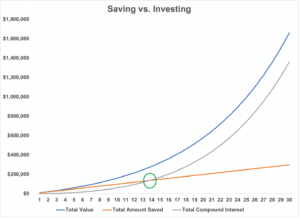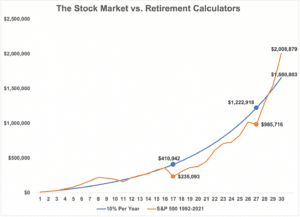Ben Carlson is one of my favorite finance writers. He has a blog called A Wealth of Common Sense and I use some of his charts in my own posts and reference the data he gathers all the time. He wrote a piece a few weeks ago about compounding that I found to be so simple, yet important to understand as an investor, that I wanted to share it here.
I’m going to take a lot from his post because I don’t know how I can explain it better than he did.

He starts by sharing an email from a reader asking the question:
“If my portfolio declines as it has over the past 6 months, am I still getting the benefits of compounding? I don’t think my brain fully comprehends the power of compounding so can you explain this in more detail?”
I’ve received this question numerous times in my career so if you’ve ever wondered about how compounding works, you’re not alone.
Compound interest is what allows you to turn your modest, consistent investment contributions into large sums of wealth. But it can be hard to wrap our minds around how it works because our brains tend to think linearly, not exponentially.
Here’s an example of how compounding would work if you saved $10,000 at the start of every year for 30 years and earned 10% on your money:

Not too shabby. You would have turned $300,000 of contributions into nearly $1.7 million.
However, while compound interest is amazing, many fail to reap its rewards because of the time and patience it requires.
In this example, your investment earnings don’t pass the amount you save until after year 14:

The total amount of investment earnings over this 30-year period would be just shy of $1.4 million, but nearly 60% of those profits come in the last 6 years. This is why how much you save matters far more than your investment returns when you’re just beginning to invest.
The problem with the above examples of compound interest is that the real world doesn’t work like an Excel spreadsheet. The stock market does not earn the same returns year after year.
Historical returns are no guarantee of future returns, but if you look back at the past 30 years the S&P 500 returned a little over 10% per year. While the average annual return was 10%, the actual yearly market returns are anything but average:

There were some great returning years and a few not-so-great years, but it was definitely not consistent year to year.

So now let’s compare the 10% per year returns to the actual yearly S&P 500 returns over the past 30 years:

As you can see, although the annual returns were the same over the past 30 years, the experience as a stock market investor was anything but smooth.
There was a 12-year period where your investment account value would’ve been below the trendline. But then stocks played catch-up in a hurry and actually ended up much higher than the consistent 10% return stream.
Compounding in the stock market isn’t easy. The S&P 500 has experienced drawdowns of -11%, -19%, -12%, -50%, -15%, -57%, -16%, -19%, -13%, -10%, -20%, -34% all within the last 30 years.
That’s why it’s important to play the long game. A long time horizon can help smooth out the ride because, despite those regular drawdowns, the U.S stock market is up over 900% since 1992.
Compounding on a spreadsheet is nice and tidy.
Compounding in the real world is messy and sporadic.
But it has to be that way because if there was no risk there would be no return.
Thanks for reading!

